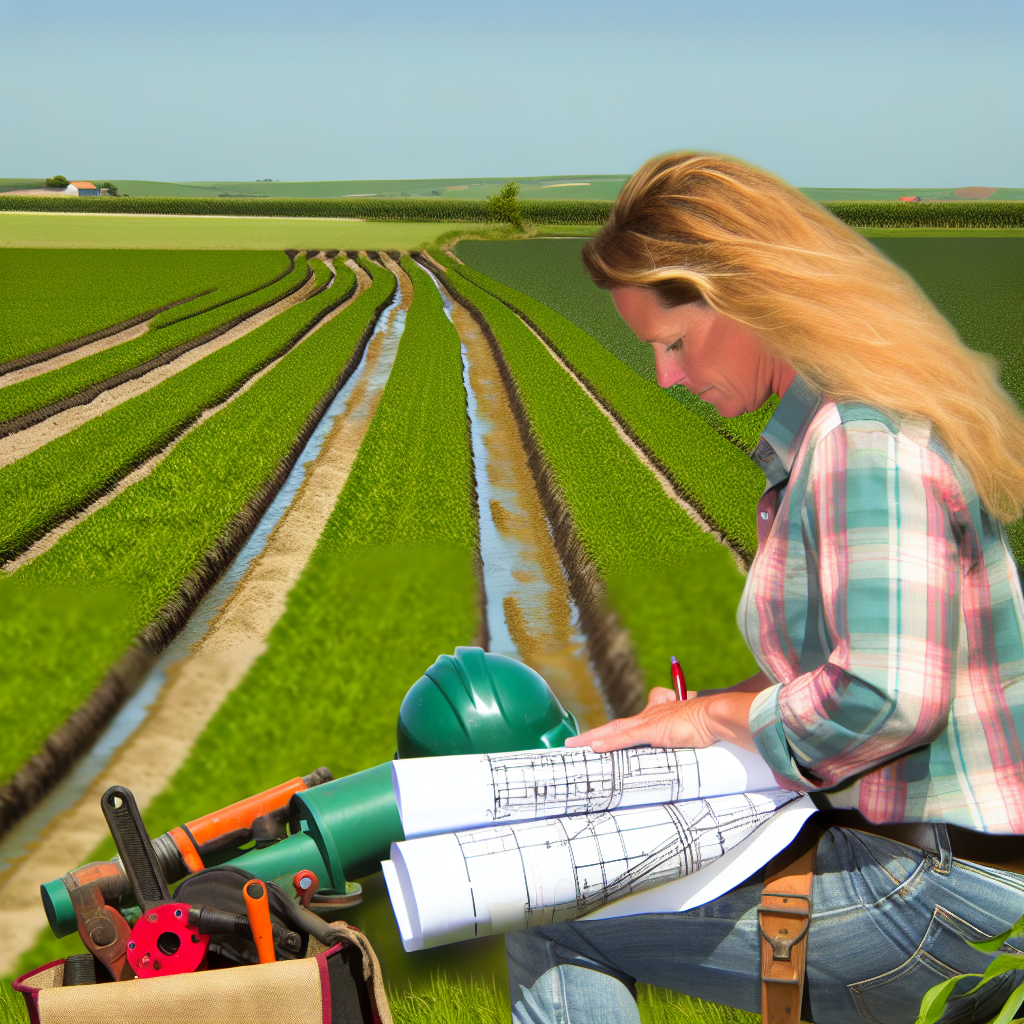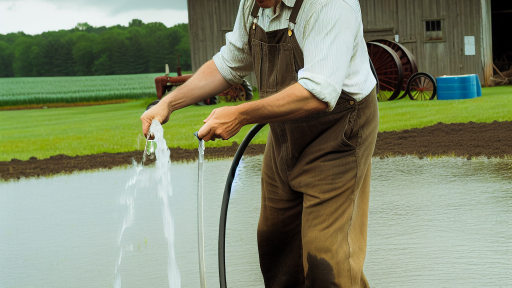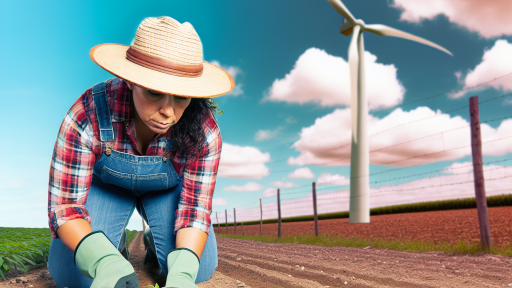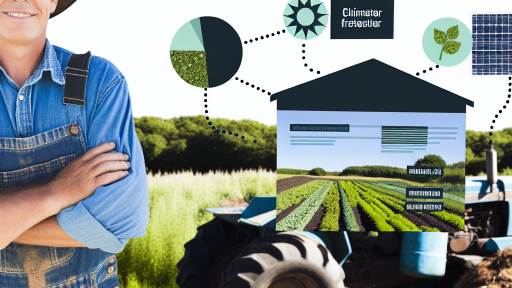Introduction to Drainage in Modern Agriculture
Drainage plays a crucial role in modern agriculture.
It helps manage excess water in crop fields.
This management enhances soil quality and crop yields.
Proper drainage systems prevent waterlogging and root diseases.
Farmers often lose significant yields due to poor drainage.
Thus, innovative solutions have emerged to address these challenges.
Importance of Effective Drainage Systems
Effective drainage systems protect crops from water stress.
They also improve soil aeration and nutrient uptake.
As a result, plants become more resilient against diseases.
Moreover, good drainage conserves soil structure and fertility.
Modern Drainage Technologies
Farmers now use advanced technologies for drainage management.
For example, subsurface drainage systems enhance water removal.
These systems consist of perforated pipes buried underground.
They collect and transport excess water away from fields.
Precision Drainage Solutions
Precision drainage technology optimizes water management practices.
Transform Your Agribusiness
Unlock your farm's potential with expert advice tailored to your needs. Get actionable steps that drive real results.
Get StartedThis approach targets specific areas needing drainage intervention.
Moreover, it minimizes disruptions to the farming process.
Environmental Considerations
Evolving drainage techniques support environmental sustainability.
They help reduce runoff and soil erosion.
In turn, this protects nearby water sources from contaminants.
Common Challenges in Drainage Management
Despite progress, farmers face challenges with drainage systems.
For instance, old systems often require maintenance or replacement.
Additionally, regional regulations may restrict drainage practices.
Farmers must navigate these obstacles to implement effective solutions.
Future Trends in Agricultural Drainage
Future drainage practices will likely incorporate smart technologies.
For instance, sensors can monitor soil moisture levels in real time.
This data aids farmers in making informed drainage decisions.
Furthermore, research continues to improve drainage methodologies.
The Importance of Drainage Systems for Crop Health
Enhancing Soil Structure
Drainage systems play a vital role in enhancing soil structure.
They prevent excessive water accumulation in fields.
As a result, soil becomes less compacted and more aerated.
This process encourages root growth and nutrient uptake.
Preventing Waterlogging
Waterlogged fields can severely damage crops.
Excess moisture restricts oxygen levels in the soil.
Consequently, crops may suffer from root rot and other diseases.
Implementing effective drainage systems mitigates these risks.
Improving Crop Yields
Optimal drainage ensures that crops receive the right amount of water.
This balance is essential for maximizing crop yields.
Farmers who prioritize drainage can often see improved harvests.
Showcase Your Farming Business
Publish your professional farming services profile on our blog for a one-time fee of $200 and reach a dedicated audience of farmers and agribusiness owners.
Publish Your ProfileIn contrast, inadequate drainage may lead to lower productivity.
Managing Fertilizer Efficiency
Proper drainage helps manage nutrient levels in the soil.
Excess moisture can lead to nutrient leaching away from root zones.
Efficient drainage maintains the availability of fertilizers for crops.
This management ultimately supports sustainable farming practices.
Supporting Eco-Friendly Practices
Effective drainage systems can align with eco-friendly practices.
They can reduce soil erosion and preserve water quality.
Moreover, they help prevent runoff, lowering environmental impact.
Integrating drainage with sustainable methods benefits entire ecosystems.
Pioneering Innovative Techniques
The evolution of drainage solutions continues to innovate.
Modern technologies offer precision drainage management.
Farmers can now adapt drainage systems based on real-time data.
This flexibility enhances both efficiency and crop health.
Overview of Traditional Drainage Methods
Importance of Drainage in Agriculture
Drainage is vital for agricultural productivity.
It prevents waterlogging and enhances soil aeration.
Farmers depend on effective drainage to manage excess water.
Common Traditional Techniques
Farmers often use surface drainage systems.
This method directs water away from fields using ditches.
Subsurface drainage also plays a role.
It employs tiles or pipes to remove excess moisture from below the surface.
These techniques have been reliable for many years.
Challenges of Traditional Methods
Despite their effectiveness, traditional methods face several challenges.
They often require significant labor and resources.
Additionally, these systems may lead to soil erosion.
Environmental concerns also arise with open ditches.
These can disrupt local ecosystems and water quality.
Regional Variations in Techniques
Drainage practices can vary by region.
For instance, flat areas may rely more on surface drainage.
In contrast, hilly terrains often use contour drainage to manage runoff.
Climate also influences the choice of drainage methods.
Wet climates necessitate more comprehensive drainage systems.
Future Considerations
As agriculture evolves, drainage techniques will need to adapt.
Innovations in technology may offer solutions to existing problems.
Research into sustainable methods will also play a crucial role.
These advancements can improve efficiency while minimizing environmental impacts.
Discover More: Mitigating Greenhouse Gases through Smart Agriculture
Innovative Drainage Technologies
Subsurface Drainage Systems
Subsurface drainage systems effectively manage excess water in agricultural fields.
These systems involve buried pipes that redirect water away from crops.
Consequently, they improve soil aeration and root development.
This technology enhances crop yield and reduces waterlogging risks.
Showcase Your Farming Business
Publish your professional farming services profile on our blog for a one-time fee of $200 and reach a dedicated audience of farmers and agribusiness owners.
Publish Your ProfileFarmers can customize the layout based on specific field conditions.
Bioreactors for Nutrient Management
Bioreactors are innovative tools for improving nutrient use efficiency.
They treat drainage water with biological processes to remove excess nutrients.
This reduces the risk of water contamination and enriches soil health.
Farmers can implement bioreactors to promote sustainable farming practices.
Moreover, this approach minimizes negative environmental impacts.
Benefits of Modern Drainage Solutions
Modern drainage solutions offer numerous benefits for farmers.
Firstly, they increase agricultural resilience against extreme weather conditions.
Secondly, these systems reduce soil erosion and nutrient runoff.
Additionally, they help maintain optimal moisture levels in the soil.
Thus, farmers can maximize productivity while minimizing resource use.
Examples of Successful Implementation
Farmers across various regions are successfully implementing these technologies.
For instance, Tom Henderson has integrated a subsurface drainage system into his farm.
This has significantly improved his crop yields and soil quality.
Similarly, Emily Carter has installed bioreactors to manage nutrient runoff.
Her efforts have resulted in healthier crops and reduced environmental impacts.
Gain More Insights: Adaptation Tactics for Sustainable Agriculture Practices
Sustainable Drainage Solutions and Their Environmental Impact
Importance of Sustainable Drainage
Sustainable drainage solutions play a crucial role in modern agriculture.
They effectively manage water resources and reduce flood risks.
Moreover, they enhance soil health by preventing waterlogging.
Consequently, these solutions contribute to improved crop yields.
Types of Sustainable Drainage Solutions
There are various sustainable drainage techniques available today.
These include bioretention systems, green roofs, and permeable pavements.
Additionally, constructed wetlands serve as effective water management tools.
Farmers can also utilize swales to channel excess water safely.
Environmental Benefits
Implementing sustainable drainage systems yields numerous environmental benefits.
First, they help maintain water quality by filtering pollutants.
Second, these solutions promote groundwater recharge during heavy rains.
Third, they support biodiversity by creating habitats for wildlife.
Case Studies of Successful Implementation
Several agricultural organizations have adopted sustainable drainage practices.
The Green Valley Farm successfully integrated bioretention areas into their landscape.
This approach reduced runoff and improved local water quality.
Similarly, Riverbend Organic Farms embraced swales for effective drainage.
The result was healthier crops and reduced erosion.
Challenges and Considerations
Despite their advantages, implementing sustainable drainage can pose challenges.
Cost and maintenance present significant hurdles for many farmers.
Additionally, proper site assessment is critical for success.
Farmers should tailor solutions to their unique landscapes and needs.
Future Perspectives on Sustainable Drainage
Looking forward, technology will enhance sustainable drainage practices.
Innovations in materials and design will increase effectiveness.
Showcase Your Farming Business
Publish your professional farming services profile on our blog for a one-time fee of $200 and reach a dedicated audience of farmers and agribusiness owners.
Publish Your ProfileFurthermore, education and resources will empower farmers to adopt these solutions.
Ultimately, the future of agriculture hinges on sustainable practices.
Find Out More: Adapting Farming Practices To Climate Shifts

Case Studies of Farms Implementing Innovative Drainage Solutions
Smart Drainage Systems in Action
Green Valley Farm in Ohio adopted a precision drainage system.
This system utilizes sensors to monitor soil moisture levels.
Consequently, it optimizes water drainage based on real-time data.
Farmers report a 20% increase in crop yield since implementation.
Moreover, the system reduced the need for manual labor in drainage maintenance.
Integrating Sustainable Practices
Sunny Acres Farm in California introduced bio-swales for drainage management.
These structures guide runoff water into vegetative areas.
This method enhances water infiltration and promotes biodiversity.
As a result, the farm experienced improved soil quality over time.
Additionally, local wildlife benefitted from the new habitat created.
Innovative Use of Technology
Harvest Ridge in Michigan embraced drone technology for drainage assessment.
Drones capture aerial images of the fields, identifying drainage issues.
This allows for efficient planning of drainage solutions.
The farm’s productivity increased while costs decreased.
Farmers gain valuable insights into field conditions regularly.
Community Impact and Knowledge Sharing
Riverbend Farms formed a local co-op to share drainage solutions.
Together, they tested multiple drainage techniques across farms.
This collaboration fostered valuable partnerships and knowledge exchange.
As a result, farms reported a collective improvement in drainage efficiency.
Ultimately, this initiative strengthened their community and sustainability efforts.
Learn More: Investing in Climate Resilience to Boost Farm Economics
Challenges in Adopting New Drainage Technologies
Resistance to Change
Many farmers hesitate to adopt new drainage technologies.
This reluctance stems from a comfort with traditional methods.
Additionally, longstanding practices create a sense of security.
Farmers often prefer familiar techniques over untested ones.
Change requires effort, time, and resources they may lack.
High Initial Investment
The cost of implementing new drainage systems can be substantial.
Farmers face financial constraints when considering upgrades.
This investment may include technology, labor, and training expenses.
Furthermore, the uncertainty of immediate returns deters many.
Accessing credit or financial assistance becomes crucial in such cases.
Technical Expertise Requirements
New drainage technologies often require specialized knowledge.
Farmers might not have the necessary technical background.
Training staff to manage and maintain these systems is essential.
This adds to the overall cost and complexity of implementation.
Partnerships with experts can bridge this knowledge gap.
Regulatory Hurdles
Adopting innovative drainage solutions can be hindered by regulations.
Showcase Your Farming Business
Publish your professional farming services profile on our blog for a one-time fee of $200 and reach a dedicated audience of farmers and agribusiness owners.
Publish Your ProfileCompliance with local laws often complicates technology integration.
Farmers must navigate bureaucratic processes to gain approvals.
Strict regulations can delay or even prevent new installations.
Staying updated on compliance requirements is vital for success.
Environmental Concerns
Some new drainage technologies raise environmental concerns.
Farmers worry about potential impacts on water quality and ecosystems.
Long-term environmental effects can discourage adoption.
Balancing innovation with stewardship is crucial in agriculture.
Gaining public trust and understanding is also a challenge.
Future Trends in Agricultural Drainage Systems
Smart Technology Integration
The future of agricultural drainage systems lies in smart technology integration.
Farmers will use sensors to monitor soil moisture levels.
This information will help them optimize drainage operations.
Moreover, data analytics will play a crucial role.
Farmers can analyze rainfall patterns and drainage efficiency.
Ultimately, this enhances decision-making and productivity.
Eco-Friendly Practices
Eco-friendly drainage practices are gaining traction.
These practices promote environmental sustainability.
For instance, bioretention systems filter and absorb excess water.
This process reduces runoff into water bodies.
Additionally, constructed wetlands provide natural filtration.
Farmers engage in these practices to protect ecosystems.
Regenerative Approaches
Regenerative agriculture will reshape drainage systems.
This approach emphasizes soil health and restoration.
Cover cropping helps reduce soil erosion and increases drainage capacity.
As a result, farmers enhance productivity while maintaining ecological balance.
Furthermore, integrating livestock into crop rotations benefits drainage systems.
The combination of crops and livestock nourishes the soil.
Improved Drainage Design
Innovations in drainage design are also on the horizon.
New materials will improve the durability of drainage systems.
Advanced trenching techniques will increase efficiency.
Farmers can expect more flexible designs to fit varied landscapes.
This adaptability will allow for better water management.
Regulatory Influences
Regulatory frameworks will shape the future of drainage systems.
Governments are emphasizing sustainable agricultural practices.
Agencies will likely impose stricter regulations on drainage management.
This trend will encourage the adoption of new technologies.
Farmers must prepare to comply with evolving environmental standards.
Collaboration and Knowledge Sharing
Collaboration among stakeholders is essential for innovation.
Universities, agricultural organizations, and farmers will share knowledge.
Workshops and training sessions will help disseminate new techniques.
Showcase Your Farming Business
Publish your professional farming services profile on our blog for a one-time fee of $200 and reach a dedicated audience of farmers and agribusiness owners.
Publish Your ProfileAdditionally, farmer-led initiatives will inspire community-based solutions.
Collectively, these efforts will enhance drainage practices across regions.
Additional Resources
Agriculture Innovation Strategy Full Report Data
U.S. Agriculture Innovation Strategy Directional Vision for Research




